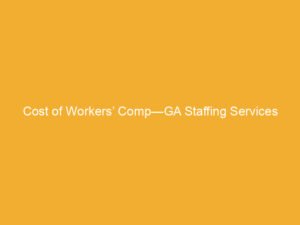
Inflation’s Impact on Workers Compensation Medical Costs
September 20, 2025
Best Workers’ Comp Providers for Temp Staffing Agencies
September 20, 2025in today’s dynamic labor market, understanding the financial implications of workers’ compensation is crucial for staffing service providers operating in Georgia. This article delves into an in-depth analysis of the cost structures associated with workers’ compensation insurance within the state’s staffing industry. By examining current trends, regulatory frameworks, and risk factors, we aim to provide staffing firms with actionable insights to better manage their workers’ comp expenses while maintaining compliance and protecting their workforce. Through this focused evaluation, Georgia staffing services can enhance their strategic planning and operational efficiency in navigating the complexities of workers’ compensation costs.
Table of Contents
- Understanding the Financial Impact of Workers’ Compensation on GA Staffing Firms
- Key Factors Driving Workers’ Comp Costs in Georgia Staffing Services
- Evaluating Risk Management Strategies to Reduce Workers’ Compensation Expenses
- Best Practices and recommendations for Optimizing Workers’ Compensation Costs in GA Staffing Agencies
- Q&A
- Final Thoughts
Understanding the Financial Impact of Workers’ Compensation on GA Staffing Firms
For staffing firms operating in Georgia, workers’ compensation represents a notable operational expense that directly influences overall profitability. Premium rates are largely determined by the industry classification, payroll size, and the firm’s claim history, meaning that effective risk management can lead to considerable cost savings. Additionally, firms must account for indirect costs such as administrative overhead and the productivity loss associated with employee injuries. These factors combined create a compelling case for implementing proactive safety programs and regular training sessions aimed at minimizing workplace incidents.
Key financial considerations for GA staffing firms include:
- Premium variability based on job classification and state regulations
- Impact of claims history on rate adjustments and surcharges
- Costs associated with injury-related absenteeism and turnover
- Benefits of investing in employee safety and return-to-work programs
| Cost Factor | Description | Financial Impact |
|---|---|---|
| Base Premium | Calculated from payroll and classification codes | High impact on fixed insurance costs |
| Claims Frequency | Number of reported injuries and claims | Affects future premium rates and surcharges |
| Lost Productivity | work hours lost due to injury | Indirect but significant operational cost |
| Safety Programs | Investment in risk reduction initiatives | Reduces long-term insurance and indirect costs |
Key Factors Driving Workers’ Comp Costs in Georgia Staffing Services
Several critical elements contribute to the fluctuations seen in workers’ compensation expenses within Georgia’s staffing sector. Employee classification plays a significant role, as different job roles carry varied risk levels influencing insurance premiums. Positions involving manual labor or higher risk of injury naturally attract higher compensation costs. Additionally, claim frequency and severity directly impact pricing; frequent claims or those requiring extended medical attention escalate overall expenditure. Another key factor is the local legal environment, where Georgia’s regulatory requirements and recent legislative changes affect how insurance providers set rates for staffing agencies.
Operational practices also bear heavily on costs.Staffing services with extensive safety programs and proactive claims management tend to experience fewer workplace incidents, leading to reduced premiums over time.moreover, the nature of client industries served-such as construction versus administrative sectors-shapes risk exposure and thus workers’ comp pricing. Below is a concise overview of some pivotal cost drivers:
- Industry-specific risk profiles
- Workforce size and turnover rates
- Claims management efficiency
- Safety training and compliance standards
| Cost Factor | Impact level | Mitigation Strategy |
|---|---|---|
| Employee Classification | high | Accurate job coding |
| Claim Frequency | Medium | Proactive safety programs |
| Legal Environment | Medium | Regular compliance reviews |
| Training & Compliance | High | Ongoing employee education |
Evaluating risk Management Strategies to Reduce Workers’ Compensation Expenses
Implementing effective risk management strategies can considerably drive down workers’ compensation costs by minimizing workplace injuries and enhancing compliance with regulatory standards.Key approaches involve conducting regular safety audits, investing in employee training programs, and developing clear interaction channels for reporting hazards. Organizations should focus on fostering a safety-first culture, which not only reduces the probability of incidents but also strengthens employee morale and productivity. Leveraging technology, such as predictive analytics and real-time monitoring, allows for proactive identification of risk factors before they escalate into costly claims.
Below is an overview of common risk management strategies and their impact on reducing claims and overall expenses:
| Strategy | Expected Impact | Implementation Cost |
|---|---|---|
| Safety Training Programs | lower injury rates, fewer claims | Medium |
| Regular Workplace Audits | Identification of hazards, reduces liability | Low |
| Early injury Reporting Systems | Faster claim resolution, cost containment | Low |
| Ergonomic Assessments | Reduced repetitive strain injuries | Medium |
By prioritizing these strategies, staffing services in Georgia can create robust frameworks that not only cut down frequency and severity of workers’ comp claims but also optimize insurance premiums and administrative expenses.A holistic risk management approach integrates employee wellbeing and operational efficiency, setting a foundation for sustainable cost savings.
Best Practices and Recommendations for Optimizing Workers’ Compensation Costs in GA Staffing Agencies
Staffing agencies in georgia can significantly control their workers’ compensation expenses by implementing proactive risk management strategies. prioritizing rigorous employee training programs tailored to the unique hazards of each job category reduces the incidence of workplace injuries. Additionally, conducting comprehensive pre-employment screenings and regular safety audits fosters a culture of accountability and vigilance, ultimately lowering claim frequency. Leveraging technology, such as real-time incident reporting apps and automated compliance trackers, ensures swift incident management and aids in maintaining regulatory compliance.
Collaboration with insurance carriers to customize policies aligned with workforce profiles can lead to more competitive premiums. Agencies should also consider establishing return-to-work programs that facilitate injured workers’ gradual reintegration, minimizing lost productivity and claim costs. Below is an exmaple of how targeted initiatives correspond with potential cost savings:
| Initiative | Impact on Claims | Estimated Cost Reduction |
|---|---|---|
| targeted Safety training | 25% fewer incidents | 15-20% |
| Pre-Employment Screening | Reduced risk exposure | 10-15% |
| Return-to-Work Programs | Faster recovery & less downtime | 18-22% |
Q&A
Q&A: Cost of Workers’ Compensation – GA staffing Services Analysis
Q1: What is the purpose of this analysis by GA Staffing Services on workers’ compensation costs?
A1: The analysis aims to provide employers and staffing agencies with a comprehensive understanding of the factors driving workers’ compensation costs, helping them manage risks and optimize their insurance expenditures effectively.
Q2: How does workers’ compensation impact staffing services financially?
A2: Workers’ compensation represents a significant portion of staffing service expenses due to the higher risk associated with temporary and contract labor. Costs can fluctuate based on claim frequency, severity, and the industry risk classification of placements.
Q3: What are the primary factors influencing workers’ compensation costs for staffing firms in Georgia?
A3: The main factors include the nature of job assignments, employee classification codes, claim history, the safety record of client sites, and state-specific regulatory requirements governing insurance premiums.
Q4: How does GA Staffing Services help mitigate workers’ compensation expenses?
A4: GA Staffing Services employs rigorous client site evaluations, implements targeted safety training programs for placed workers, and collaborates with insurers to secure competitive premiums by demonstrating proactive risk management.
Q5: Are there trends in workers’ compensation claims that affect cost projections?
A5: Yes, data indicates an increasing trend in musculoskeletal injuries and strain-related claims among temporary workers, prompting staffing firms to invest more in ergonomic training and injury prevention to control costs.
Q6: What role does claims management play in controlling workers’ comp expenses?
A6: Effective claims management minimizes losses through early intervention, timely medical care, and coordinated return-to-work programs, which collectively reduce claim duration and severity, thereby lowering overall costs.
Q7: How can businesses leverage this analysis to improve their cost control strategies?
A7: Businesses can utilize the insights to benchmark their workers’ compensation costs, identify high-risk placements, prioritize safety measures, and negotiate better insurance terms aligned with their specific risk profiles.
Q8: What future developments could influence workers’ comp costs in Georgia’s staffing sector?
A8: Legislative changes, advancements in workplace safety technology, and evolving workforce demographics are likely to impact claims frequency and cost structures, necessitating ongoing monitoring and adaptive strategies.
This Q&A provides a strategic overview for stakeholders seeking to understand and manage workers’ compensation costs in georgia’s staffing industry.
Final Thoughts
understanding the cost dynamics of workers’ compensation is critical for Georgia staffing services aiming to maintain profitability while ensuring employee protection. By leveraging comprehensive data analysis and implementing strategic risk management practices, staffing firms can better anticipate expenses, optimize coverage, and ultimately reduce financial liabilities. Staying informed on regulatory changes and industry trends will further empower businesses to make data-driven decisions that balance cost efficiency with workforce safety. As the landscape of workers’ comp evolves, proactive management remains the key to sustaining a competitive edge in Georgia’s staffing sector.
“This content was generated with the assistance of artificial intelligence. While we strive for accuracy, AI-generated content may not always reflect the most current information or professional advice. Users are encouraged to independently verify critical information and, where appropriate, consult with qualified professionals, lawyers, state statutes and regulations & NCCI rules & manuals before making decisions based on this content.

